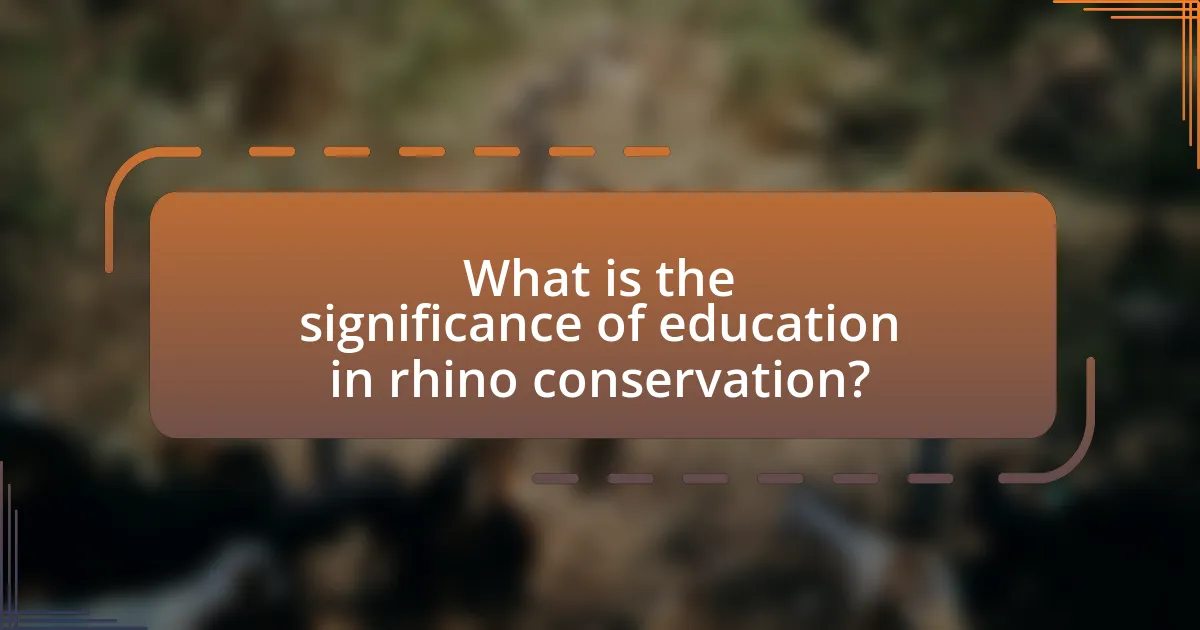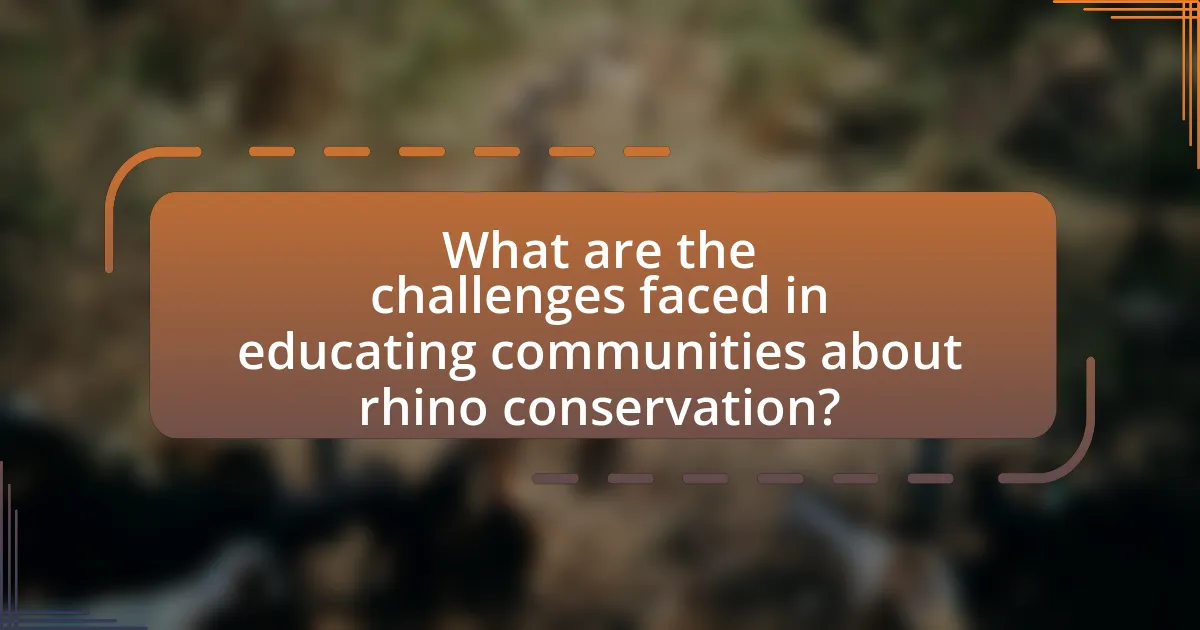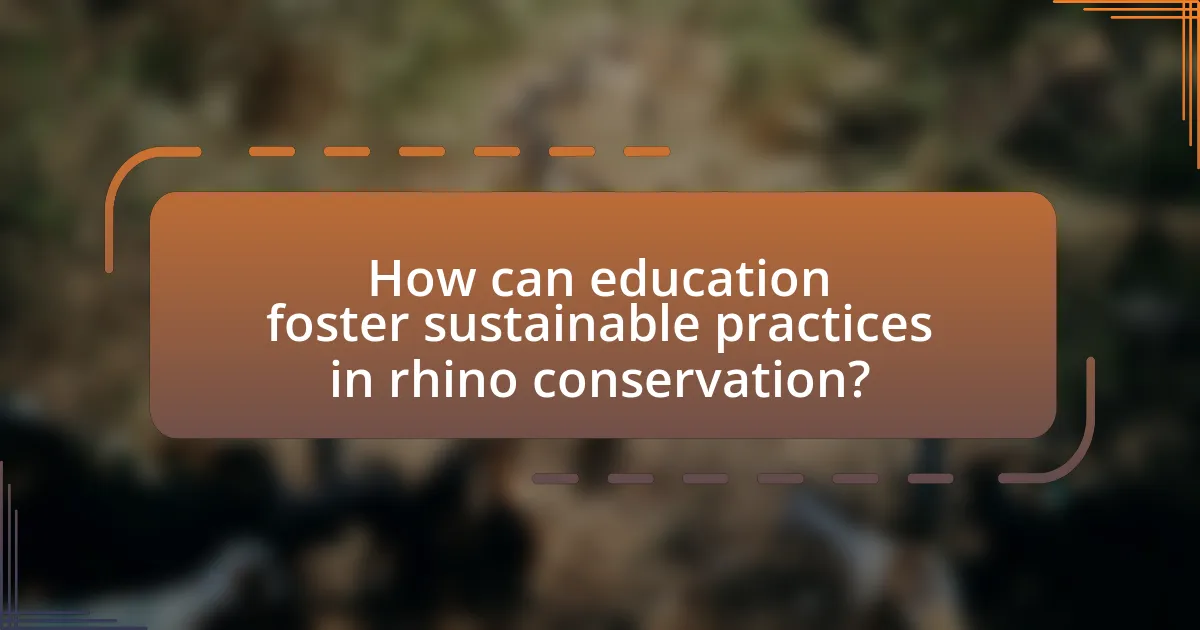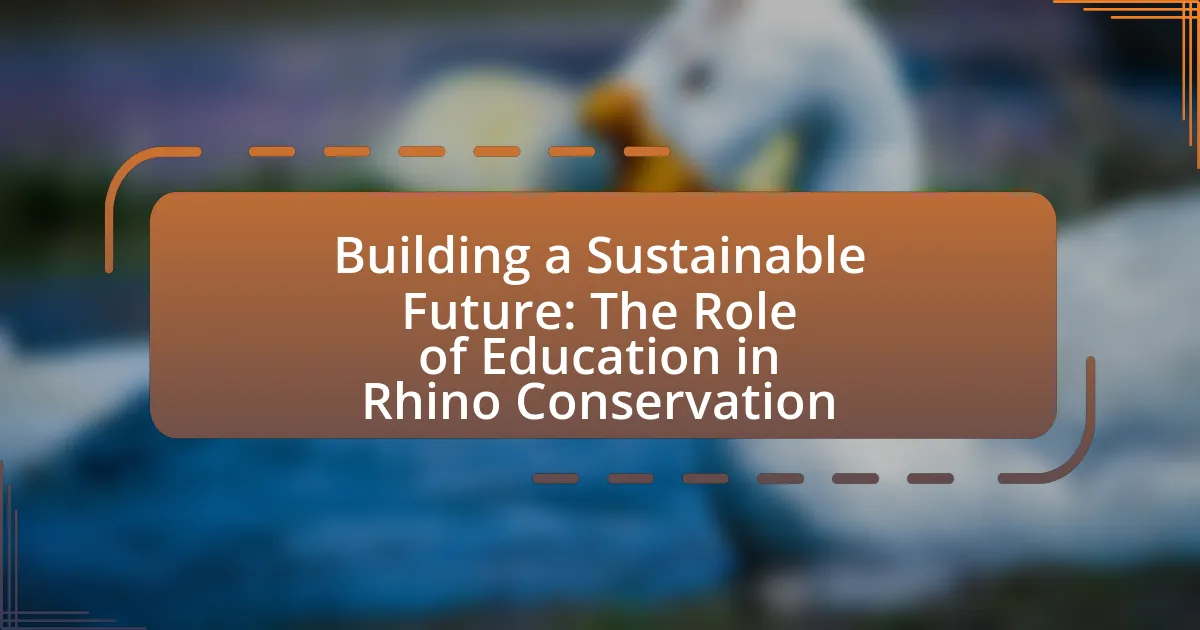The article focuses on the critical role of education in rhino conservation, emphasizing its significance in raising awareness about the threats faced by rhinos and promoting sustainable practices. It outlines how educational initiatives can influence public awareness, community attitudes, and support for conservation efforts, highlighting successful strategies such as community engagement and school-based programs. The article also discusses the ecological importance of rhinos, the challenges in educating communities, and the impact of cultural beliefs and misconceptions on conservation efforts. Additionally, it examines the resources available for educational initiatives and the effectiveness of technology and social media in enhancing outreach and engagement in rhino conservation.

What is the significance of education in rhino conservation?
Education is significant in rhino conservation as it raises awareness about the threats facing rhinos and promotes sustainable practices. By informing communities about the ecological importance of rhinos and the consequences of poaching, education fosters a sense of responsibility and encourages local involvement in conservation efforts. For instance, programs that educate local populations have been shown to reduce poaching rates by up to 50% in certain regions, demonstrating the direct impact of informed communities on wildlife protection.
How does education influence public awareness about rhinos?
Education significantly enhances public awareness about rhinos by providing critical information on their ecological importance and the threats they face. Through educational programs, individuals learn about rhino conservation efforts, the impact of poaching, and the role of rhinos in biodiversity. For instance, studies have shown that communities engaged in educational initiatives exhibit increased knowledge and positive attitudes towards wildlife conservation, leading to greater support for protective measures. Furthermore, organizations like the World Wildlife Fund emphasize that educational outreach can lead to behavioral changes, fostering a culture of conservation that benefits rhinos and their habitats.
What are the key educational strategies used in rhino conservation?
Key educational strategies used in rhino conservation include community engagement, awareness campaigns, and school-based education programs. Community engagement involves collaborating with local populations to foster a sense of ownership and responsibility towards rhino conservation, which has been shown to reduce poaching rates. Awareness campaigns utilize various media platforms to inform the public about the threats facing rhinos and the importance of conservation efforts, leading to increased support and funding for initiatives. School-based education programs teach children about wildlife conservation, instilling values of environmental stewardship from a young age, which is crucial for long-term sustainability. These strategies collectively enhance knowledge, promote positive attitudes, and encourage active participation in rhino conservation efforts.
How do educational programs impact community attitudes towards rhinos?
Educational programs significantly improve community attitudes towards rhinos by increasing awareness and understanding of their ecological importance and conservation needs. Research indicates that communities engaged in educational initiatives demonstrate a greater appreciation for rhinos, leading to enhanced support for conservation efforts. For instance, a study conducted by the World Wildlife Fund found that communities participating in rhino education programs showed a 40% increase in positive attitudes towards rhino conservation compared to those without such programs. This shift in perspective often results in reduced poaching and increased community involvement in conservation activities, thereby fostering a more sustainable coexistence with rhinos.
Why is rhino conservation critical for biodiversity?
Rhino conservation is critical for biodiversity because rhinos play a vital role in their ecosystems as megaherbivores, influencing vegetation structure and habitat availability for numerous other species. By grazing on grasses and browsing on shrubs, rhinos help maintain the balance of their habitats, which supports a diverse array of flora and fauna. For instance, the presence of rhinos can promote the growth of certain plant species that depend on their grazing patterns, thereby enhancing overall ecosystem health. Additionally, the decline of rhino populations can lead to overgrowth of vegetation, which may negatively impact other species that rely on open habitats. This ecological interdependence underscores the importance of conserving rhinos to preserve biodiversity and maintain healthy ecosystems.
What role do rhinos play in their ecosystems?
Rhinos play a crucial role in their ecosystems as keystone species, significantly influencing the structure and function of their habitats. By grazing on grasses and browsing on shrubs, rhinos help maintain the balance of vegetation, which in turn supports a diverse array of wildlife. Their feeding habits promote the growth of certain plant species while preventing overgrowth, thereby fostering biodiversity. Additionally, rhinos contribute to nutrient cycling through their dung, which enriches the soil and supports plant growth. This ecological impact is vital for the health of savanna and grassland ecosystems, where rhinos are often found.
How does the decline of rhino populations affect other species?
The decline of rhino populations negatively impacts other species by disrupting ecosystem balance. Rhinos are considered keystone species; their grazing habits help maintain the structure of grasslands and promote biodiversity. For instance, the loss of rhinos can lead to overgrowth of certain plant species, which in turn affects herbivores that rely on a diverse range of vegetation for food. Additionally, the decline of rhinos can alter predator-prey dynamics, as the absence of rhinos may lead to increased populations of smaller herbivores, which can overgraze and degrade habitats. This cascading effect illustrates how the decline of rhino populations can lead to diminished biodiversity and altered ecosystems.

What are the challenges faced in educating communities about rhino conservation?
Educating communities about rhino conservation faces several challenges, including cultural beliefs, economic pressures, and lack of access to information. Cultural beliefs may lead to misconceptions about rhinos and their conservation, making it difficult to change attitudes. Economic pressures, such as poverty, can prioritize immediate survival over conservation efforts, leading to poaching and habitat destruction. Additionally, a lack of access to reliable information and educational resources can hinder effective communication about the importance of rhino conservation. These challenges are supported by studies indicating that community engagement and education are crucial for successful conservation outcomes, as seen in initiatives that have improved local attitudes towards wildlife through targeted educational programs.
How do cultural beliefs impact conservation education efforts?
Cultural beliefs significantly impact conservation education efforts by shaping community values and attitudes towards wildlife and environmental stewardship. For instance, in cultures where animals are revered or considered sacred, conservation education can leverage these beliefs to foster protective behaviors towards species like rhinos. Research indicates that integrating local cultural narratives into conservation programs enhances community engagement and compliance, as seen in initiatives that respect indigenous knowledge and practices. This approach not only promotes awareness but also encourages sustainable practices aligned with cultural values, ultimately leading to more effective conservation outcomes.
What misconceptions about rhinos hinder conservation efforts?
Misconceptions about rhinos that hinder conservation efforts include the belief that rhino horns possess medicinal properties and the assumption that rhinos are not endangered. The false notion that rhino horns can cure ailments, such as cancer, drives illegal poaching, as evidenced by the fact that the demand for rhino horn in traditional medicine markets, particularly in Asia, remains high despite scientific evidence disproving its efficacy. Additionally, the misconception that rhinos are abundant leads to a lack of urgency in conservation efforts; in reality, the International Union for Conservation of Nature reports that three of the five rhino species are critically endangered, with populations declining due to habitat loss and poaching. These misconceptions create barriers to effective conservation strategies and public support.
How can education address these misconceptions effectively?
Education can effectively address misconceptions about rhino conservation by implementing targeted awareness programs that provide accurate information and engage communities. These programs can include workshops, interactive sessions, and educational materials that clarify the ecological importance of rhinos and the threats they face, such as poaching and habitat loss. Research indicates that educational interventions can significantly change attitudes and behaviors; for instance, a study published in the Journal of Environmental Education found that participants who engaged in conservation education were more likely to support protective measures for endangered species. By fostering a deeper understanding of rhinos’ roles in ecosystems and the consequences of their decline, education can empower individuals to become advocates for conservation efforts.
What resources are available for educational initiatives in rhino conservation?
Educational initiatives in rhino conservation have access to various resources, including funding from organizations like the World Wildlife Fund and the International Rhino Foundation, which support educational programs and awareness campaigns. Additionally, educational materials such as documentaries, online courses, and interactive workshops are provided by conservation groups to enhance public understanding of rhino conservation issues. Research studies, like those published in the journal “Conservation Biology,” highlight the effectiveness of educational outreach in increasing community engagement and support for rhino protection efforts. These resources collectively contribute to building a sustainable future for rhinos through informed public participation and advocacy.
Which organizations are leading educational efforts in rhino conservation?
The organizations leading educational efforts in rhino conservation include the World Wildlife Fund (WWF), Save the Rhino International, and the International Rhino Foundation. These organizations actively engage in educational programs aimed at raising awareness about rhino conservation, promoting sustainable practices, and supporting anti-poaching initiatives. For instance, WWF has developed educational resources and campaigns that reach millions globally, emphasizing the importance of rhinos in ecosystems and the threats they face. Save the Rhino International focuses on community engagement and education in regions where rhinos are found, fostering local stewardship for wildlife. The International Rhino Foundation also provides educational materials and supports conservation education initiatives in schools and communities.
What types of materials and programs are most effective for education?
Interactive and experiential learning materials, such as hands-on workshops and field trips, are most effective for education, particularly in the context of conservation. These methods engage learners actively, fostering a deeper understanding of complex topics like rhino conservation. Research indicates that experiential learning can enhance retention rates by up to 75%, compared to traditional lecture-based approaches, which typically yield retention rates of around 5-10%. Programs that incorporate multimedia resources, such as documentaries and interactive digital platforms, also prove effective by appealing to various learning styles and increasing engagement.

How can education foster sustainable practices in rhino conservation?
Education can foster sustainable practices in rhino conservation by increasing awareness and understanding of the ecological importance of rhinos and the threats they face. Through targeted educational programs, individuals learn about the role of rhinos in their ecosystems, the impact of poaching, and the importance of biodiversity. For instance, studies have shown that community-based education initiatives can lead to a significant reduction in poaching rates, as local populations become more invested in conservation efforts. Additionally, educational outreach can empower communities to engage in sustainable tourism practices that benefit both the economy and rhino populations, demonstrating that conservation can coexist with human development.
What role do schools play in promoting rhino conservation?
Schools play a crucial role in promoting rhino conservation by educating students about the importance of biodiversity and the threats faced by rhinos. Through curriculum integration, schools can teach students about wildlife conservation, ecological balance, and the impact of poaching. For instance, programs like the World Wildlife Fund’s “Rhino Adoption” initiative allow students to engage directly with conservation efforts, fostering a sense of responsibility and stewardship. Additionally, schools often organize field trips to wildlife reserves and conservation centers, providing hands-on learning experiences that reinforce the significance of protecting rhinos and their habitats. This educational approach not only raises awareness among students but also encourages them to advocate for conservation in their communities, thereby amplifying the impact of their learning.
How can curriculum integration enhance awareness of rhino issues?
Curriculum integration can enhance awareness of rhino issues by embedding conservation topics across various subjects, making them relevant and engaging for students. This approach allows learners to explore rhino conservation through science, geography, and social studies, fostering a holistic understanding of the ecological and socio-economic factors affecting rhinos. For instance, integrating rhino-related case studies in biology classes can illustrate the impact of poaching on biodiversity, while geography lessons can examine the habitats and migration patterns of rhinos. Research indicates that interdisciplinary learning increases retention and encourages critical thinking, which is essential for developing informed advocates for rhino conservation.
What projects can students engage in to support rhino conservation?
Students can engage in various projects to support rhino conservation, including habitat restoration initiatives, awareness campaigns, and fundraising events. Habitat restoration projects involve planting native vegetation and removing invasive species to improve the ecosystems where rhinos live. Awareness campaigns can include creating educational materials or organizing workshops to inform the community about the threats rhinos face, such as poaching and habitat loss. Fundraising events, such as charity runs or art auctions, can generate financial support for rhino conservation organizations. These activities not only contribute to conservation efforts but also educate students about the importance of biodiversity and wildlife protection.
How can technology enhance educational outreach for rhino conservation?
Technology can enhance educational outreach for rhino conservation by utilizing digital platforms, interactive tools, and data analytics to engage and inform diverse audiences. For instance, virtual reality experiences allow users to immerse themselves in rhino habitats, fostering empathy and understanding of conservation challenges. Additionally, social media campaigns can reach millions, spreading awareness and mobilizing support for conservation efforts. Data analytics can track engagement metrics, helping organizations refine their outreach strategies based on audience responses. These methods have proven effective; for example, the World Wildlife Fund reported a significant increase in public engagement through their digital initiatives, demonstrating the power of technology in conservation education.
What digital tools are being used to educate about rhinos?
Digital tools used to educate about rhinos include interactive websites, mobile applications, virtual reality experiences, and social media platforms. Interactive websites provide comprehensive information on rhino species, conservation efforts, and ways to get involved, while mobile applications offer educational games and tracking features for rhino populations. Virtual reality experiences allow users to immerse themselves in rhino habitats, enhancing awareness and empathy. Social media platforms facilitate the sharing of educational content, updates on conservation initiatives, and community engagement. These tools collectively enhance public understanding and support for rhino conservation efforts.
How effective are social media campaigns in raising awareness?
Social media campaigns are highly effective in raising awareness, particularly in conservation efforts like rhino protection. Research indicates that campaigns leveraging platforms such as Facebook and Instagram can reach millions, significantly amplifying messages about endangered species. For instance, a study by the University of Kent found that social media posts related to wildlife conservation increased engagement by over 200%, leading to heightened public awareness and support for initiatives. This demonstrates that social media serves as a powerful tool for disseminating information and mobilizing community action in conservation efforts.
What are best practices for implementing educational programs in rhino conservation?
Best practices for implementing educational programs in rhino conservation include engaging local communities, integrating traditional ecological knowledge, and utilizing interactive learning methods. Engaging local communities fosters ownership and responsibility towards conservation efforts, as seen in programs like the African Wildlife Foundation’s community-based initiatives, which have led to increased local participation in rhino protection. Integrating traditional ecological knowledge respects and utilizes the wisdom of indigenous populations, enhancing the relevance and effectiveness of educational content. Utilizing interactive learning methods, such as workshops and field trips, has been shown to improve retention and inspire action, as evidenced by the success of the Rhino Conservation Education Program in South Africa, which increased awareness and support for rhino conservation among students.
How can community involvement be encouraged in educational initiatives?
Community involvement in educational initiatives can be encouraged by fostering partnerships between schools and local organizations. These partnerships can facilitate resource sharing, such as guest speakers from conservation groups, which enhances the educational experience and raises awareness about rhino conservation. Research indicates that community-based programs, like those implemented by the World Wildlife Fund, have successfully engaged local populations in conservation efforts, leading to increased participation and support for educational initiatives. By integrating local knowledge and cultural perspectives into the curriculum, educational initiatives can become more relevant and appealing to the community, thereby boosting involvement.
What metrics can be used to measure the success of educational programs?
Metrics used to measure the success of educational programs include student performance, retention rates, participant engagement, and feedback surveys. Student performance can be assessed through standardized test scores and grades, which provide quantifiable data on knowledge acquisition. Retention rates indicate the percentage of students who complete the program, reflecting its effectiveness in maintaining interest and commitment. Participant engagement can be measured through attendance records and active participation in discussions or activities, showcasing the program’s ability to captivate learners. Feedback surveys collect qualitative data from participants regarding their experiences and perceived value of the program, offering insights into areas for improvement. These metrics collectively provide a comprehensive evaluation of educational program success.
